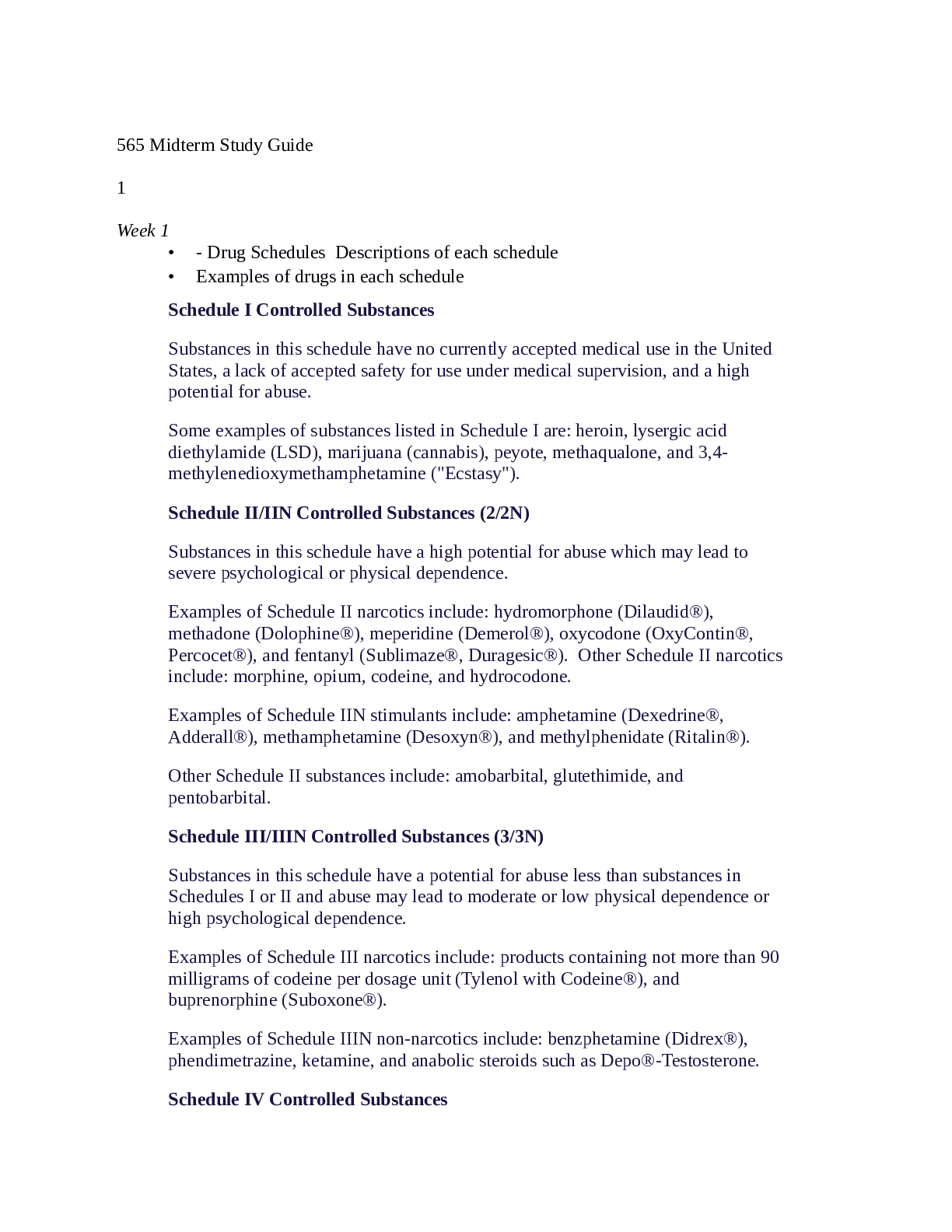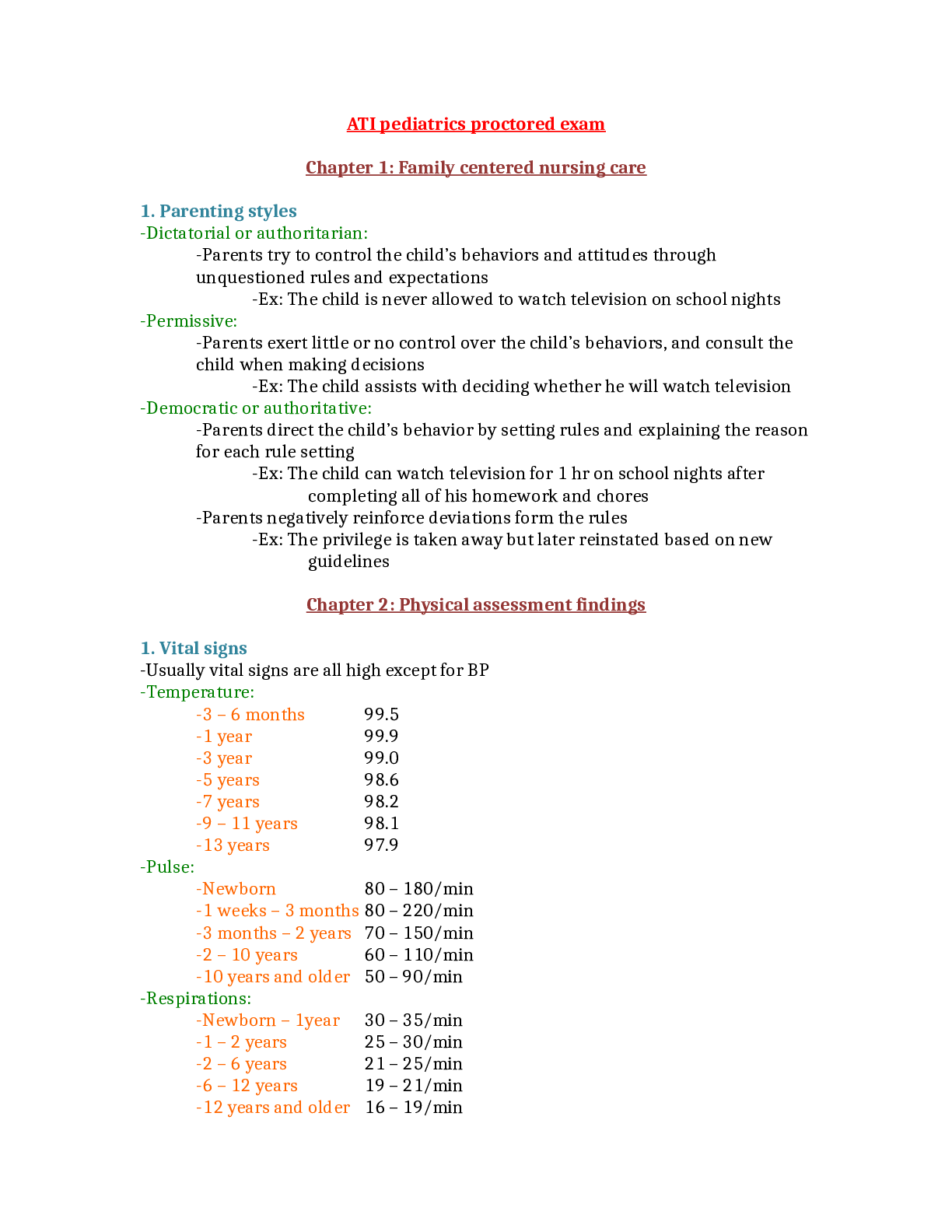Health Care > STUDY GUIDE > PHARMACOLOGY MIDTERM STUDY GUIDE (2021/2022) (All)
PHARMACOLOGY MIDTERM STUDY GUIDE (2021/2022)
Document Content and Description Below
PHARMACOLOGY MIDTERM STUDY GUIDE (2021/2022) Week 1 •- Drug Schedules Descriptions of each schedule •Examples of drugs in each schedule Schedule I Controlled Substances Substances in this s... chedule have no currently accepted medical use in the United States, a lack of accepted safety for use under medical supervision, and a high potential for abuse. Some examples of substances listed in Schedule I are: heroin, lysergic acid diethylamide (LSD), marijuana (cannabis), peyote, methaqualone, and 3,4- methylenedioxymethamphetamine ("Ecstasy"). Schedule II/IIN Controlled Substances (2/2N) Substances in this schedule have a high potential for abuse which may lead to severe psychological or physical dependence. Examples of Schedule II narcotics include: hydromorphone (Dilaudid®), methadone (Dolophine®), meperidine (Demerol®), oxycodone (OxyContin®, Percocet®), and fentanyl (Sublimaze®, Duragesic®). Other Schedule II narcotics include: morphine, opium, codeine, and hydrocodone. Examples of Schedule IIN stimulants include: amphetamine (Dexedrine®, Adderall®), methamphetamine (Desoxyn®), and methylphenidate (Ritalin®). Other Schedule II substances include: amobarbital, glutethimide, and pentobarbital. Schedule III/IIIN Controlled Substances (3/3N) Substances in this schedule have a potential for abuse less than substances in Schedules I or II and abuse may lead to moderate or low physical dependence or high psychological dependence. Examples of Schedule III narcotics include: products containing not more than 90 milligrams of codeine per dosage unit (Tylenol with Codeine®), and buprenorphine (Suboxone®). Examples of Schedule IIIN non-narcotics include: benzphetamine (Didrex®), phendimetrazine, ketamine, and anabolic steroids such as Depo®-Testosterone. Schedule IV Controlled Substances Substances in this schedule have a low potential for abuse relative to substances in Schedule III. Examples of Schedule IV substances include: alprazolam (Xanax®), carisoprodol (Soma®), clonazepam (Klonopin®), clorazepate (Tranxene®), diazepam (Valium®), lorazepam (Ativan®), midazolam (Versed®), temazepam (Restoril®), and triazolam (Halcion®). Schedule V Controlled Substances Substances in this schedule have a low potential for abuse relative to substances listed in Schedule IV and consist primarily of preparations containing limited quantities of certain narcotics. Examples of Schedule V substances include: cough preparations containing not more than 200 milligrams of codeine per 100 milliliters or per 100 grams (Robitussin AC®, Phenergan with Codeine®), and ezogabine. •Which ones can and can not be prescribed by nurse practitioners ➢They can prescribe all but schedule 1 because they are not legal. Varies by state •Prescriptive Authority •Understand what prescriptive authority is and who mandates it. ➢State mandates it under the jurisdiction of the health professional board. (state board of nursing, board of medicine or board of pharmacy). Federal government controls drug regulations but has no control over prescriptive authority. Prescriptive authority is the legal right to prescribe drugs. Full authority is being able to prescribe independently without limitations. MDs and DOs have no limits. Limitations are tied to oversight of the doctor or DO. Being able to prescribe independently means is not subject to rules requiring physician supervision or collaboration. Florida III-V collaborative. •What problems arise when it is limited? ➢Barriers include quality, affordable, and accessible patient care. Can increase patient waits •Know the responsibilities of prescribing ➢Must consider cost, availability, interactions with either food or other medications, side effects, allergies, how the drug is metabolized (hepatic or renal), need for monitoring (labs, effectiveness, ect) special populations (pregnancy, nursing mothers, or older adults) •Know patient reasons for medication non-adherence ➢Missed a dose, forgot to take a dose, did not refill medication in time, took lower than prescribed dose, did not refill medication, stopped taking medication. ➢Reason why includes forgot a dose, ran out, was away from home, trying to save money, did not like the side effects, was too busy, the medication didn’t work, didn’t believe medication was necessary, didn’t like taking the medication. Failure to comprehend instructions for reasons such as visual, intellectual or auditory impairment, use of complex regimens (taking several drugs multiple times a day) [Show More]
Last updated: 1 year ago
Preview 1 out of 15 pages
Instant download

Buy this document to get the full access instantly
Instant Download Access after purchase
Add to cartInstant download
Reviews( 0 )
Document information
Connected school, study & course
About the document
Uploaded On
Apr 12, 2023
Number of pages
15
Written in
Additional information
This document has been written for:
Uploaded
Apr 12, 2023
Downloads
0
Views
27



.png)
.png)



.png)
.png)






